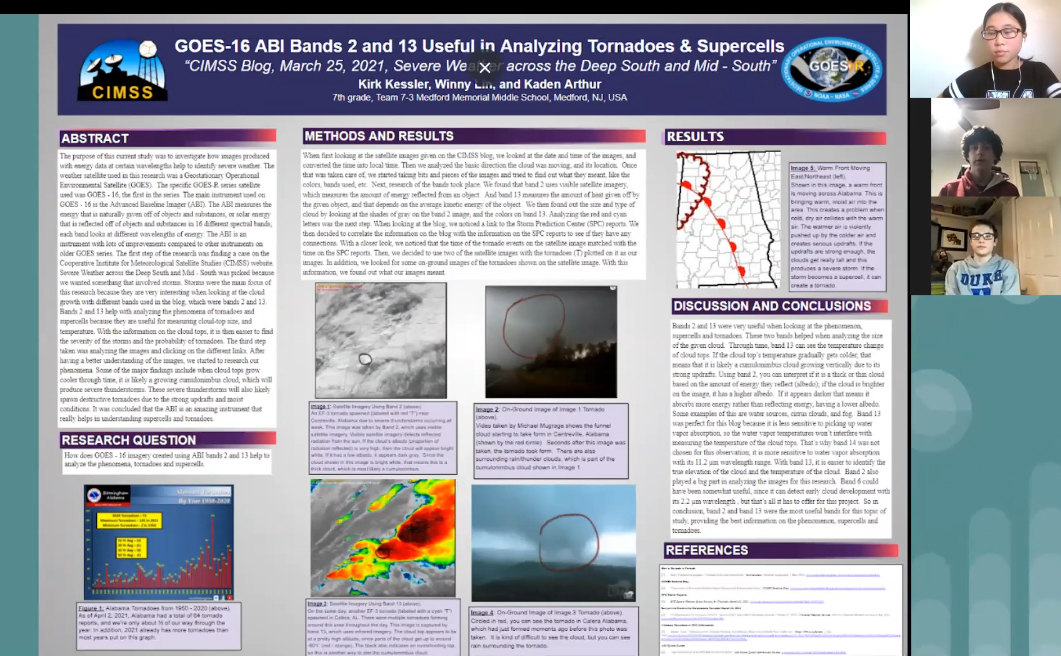HIGH SCHOOL 1st Place: Tornado Predictability With GOES-R: A Case Study of April 23rd, 2021
Matthew Casertano, Malcolm Maas, Heerok Das, Jason Liu
Montgomery Blair High School, Silver Spring, Maryland
COACH: Erik Lodal
|
View the poster presentation  |
ABSTRACT: Though tornadoes attract chasers from all over and may even seem eerily beautiful from a distance, their destructive power is immense. A single tornado, such as the 1925 Tri-State tornado or the 2011 Joplin tornado, can kill hundreds, injure thousands, and cause billions of dollars in damage in just hours. With hundreds of tornadoes hitting the U.S. alone every year, it is critical that tornadoes are forecasted accurately for citizens and municipalities to adequately prepare. The GOES-R series satellites are an essential tool for this, offering more spectral data, higher spatial resolution, and faster temporal coverage than the previous generations. By analyzing GOES-16 ABI imagery leading up to a tornadic severe weather event on April 23, 2021, we measured how far in advance various ingredients for tornado formation could be detected. Different bands revealed unique key atmospheric properties or phenomena, and we highlighted the significance of these in our project. Ultimately, a few tornadoes were produced on April 23, which damaged farms and homes; fortunately, no one was injured. Our research will provide useful information to anyone trying to forecast future tornadoes with satellite observations, potentially saving lives by giving people more lead time for tornado threats. |
|
Honorable Mention:
GOES Capabilities In Detecting Local Fires, John Aguilera, Mission Viejo High School, Mission Viejo, Ca. |
||
MIDDLE SCHOOL 1st PLACE: GOES-16 ABI Bands 2, 13 Useful in Analyzing Tornadoes and Supercells
Winny Lin, Kirk Kessler, Kaden Arthur
Medford Memorial Middle School, Medford NJ
COACH: Vicky Gorman
|
ABSTRACT: The purpose of this current study was to investigate how images produced with energy data at certain wavelengths help to identify severe weather. The first step of the research was finding a case on the Cooperative Institute for Meteorological Satellite Studies (CIMSS) website. Severe Weather across the Deep South and Mid - South was picked because we wanted something that involved storms. Storms were the main focus of this research because they are very interesting when looking at the cloud growth with different bands used in the blog, which were bands 2 and 13. Bands 2 and 13 help with analyzing the phenomena of tornadoes and supercells because they are useful for measuring cloud-top size, and temperature. Some of the major findings include when cloud tops grow cooler through time, it is likely a growing cumulonimbus cloud, which will produce severe thunderstorms. These severe thunderstorms will also likely spawn destructive tornadoes due to the strong updrafts and moist conditions. It was concluded that the ABI is an amazing instrument that really helps in understanding supercells and tornadoes.
|

|
Honorable Mentions:
GOES-16 ABI Bands 5, 6, and 7 Useful in Analyzing Prescribed Burns, Madison Pisarski, Medford Memorial MS
Click here to VIEW MADISON'S SCIENTIFIC POSTER.
GOES-16 and GOES-17 ABI Bands 13, 9, and 2 Useful in Analyzing Spread of Ash and Its Effect on the Weather, Madalynn Kusmiesz and Macy Coccaro, Medford Memorial MS
Click here to VIEW THEIR SCIENTIFIC POSTER.
